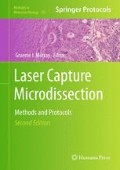Abstract
Barrett’s esophageal adenocarcinoma (BEAC) arises from Barrett’s esophagus (BE), a premalignant lesion caused by acid reflux (heartburn). Although the cancer is uncommon, its incidence is rapidly rising in western countries. Like most other cancers, BEAC cells also have elevated telomerase activity which maintains telomere length and supports continued proliferation of these cells. It is not clear if telomerase is activated early at premalignant (BE) stage, because reports of telomerase activity in Barrett’s and normal esophagi have been controversial. We have shown that detection of telomerase and telomeres becomes easier and much more reliable if purified BE cells are used instead of tissue specimens. This chapter, therefore, emphasizes the importance of laser capture microdissection and provides the method to purify Barrett’s esophagus related cells, using this technique.
Access this chapter
Tax calculation will be finalised at checkout
Purchases are for personal use only
References
Devesa SS, Blot WJ, Fraumeni JF, Jr. (1998) Changing patterns in the incidence of esophageal and gastric carcinoma in the United States. Cancer. 83:2049–2053.
Spechler SJ, Goyal RK. (1986) Barrett’s esophagus. N Engl J Med. 315:362–371.
Blot WJ, McLaughlin JK. (1999) The changing epidemiology of esophageal cancer. Semin Oncol. 26:2–8.
Morales CP, Lee EL, Shay JW. (1998) In situ hybridization for the detection of telomerase RNA in the progression from Barrett’s esophagus to esophageal adenocarcinoma. Cancer. 83:652–659.
Lord RV, Salonga D, Danenberg KD, et al. (2000) Telomerase reverse transcriptase expression is increased early in the Barrett’s metaplasia, dysplasia, adenocarcinoma sequence. J Gastrointest Surg. 4:135–142.
Aisner DL, Wright WE, Shay JW. (2002) Telomerase regulation: not just flipping the switch. Curr Opin Genet Dev. 12:80–85.
Cong YS, Wright WE, Shay JW. (2002) Human telomerase and its regulation. Microbiol Mol Biol Rev. 2002;66:407–425.
Barclay JY, Morris A, Nwokolo CU. (2005) Telomerase, hTERT and splice variants in Barrett’s oesophagus and oesophageal adenocarcinoma. Eur J Gastroenterol Hepatol. 17:221–227.
Yoneyama K, Aoyama N, Koizumi H, Tamai S. (1998) Telomerase activity in esophageal carcinoma and lesions unstained with Lugol’s solution. Nippon Rinsho. 56:1181–1185.
Bachor C, Bachor OA, Boukamp P. (1999) Telomerase is active in normal gastrointestinal mucosa and not up-regulated in precancerous lesions. J Cancer Res Clin Oncol. 125:453–460.
Going JJ, Fletcher-Monaghan AJ, Neilson L, et al. (2004) Zoning of mucosal phenotype, dysplasia, and telomerase activity measured by telomerase repeat assay protocol in Barrett’s esophagus. Neoplasia. 6:85–92.
Harle-Bachor C, Boukamp P. (1996) Telomerase activity in the regenerative basal layer of the epidermis inhuman skin and in immortal and carcinoma-derived skin keratinocytes. Proc Natl Acad Sci USA. 93:6476–6481.
Emmert-Buck MR, Bonner RF, Smith PD, Chuaqui RF, Zhuang Z, Goldstein SR, Weiss RA, Liotta LA. (1996) Laser capture microdissection. Sci. 274(5289):998–1001.
Collaud S, Wiedl T, Cattaneo E, Soltermann A, Hillinger S, Weder W, Arni S. (2010) Laser-capture microdissection impairs activity-based protein profiles for serine hydrolase in human lung adenocarcinoma. Biomol Tech. 21(1):25–28.
Shammas MA, Qazi A, Batchu RB, et al. (2008) Telomere maintenance in laser capture microdissection-purified Barrett’s adenocarcinoma cells and effect of telomerase inhibition in vivo. Clin Cancer Res. 14:4971–4980.
Huang Q, Yu C, Klein M, Fang J, Goyal RK. (2005) DNA index determination with Automated Cellular Imaging System (ACIS) in Barrett’s esophagus: comparison with CAS 200. BMC Clin Pathol. 5:7.
Ohyama H, Zhang X, Kohno Y, et al. (2000) Laser capture microdissection-generated target sample for high-density oligonule‑tide array hybridization. Biotechniques. 29:530–536.
Author information
Authors and Affiliations
Corresponding author
Editor information
Editors and Affiliations
Rights and permissions
Copyright information
© 2011 Springer Science+Business Media, LLC
About this protocol
Cite this protocol
Shammas, M.A., Rao, M.Y. (2011). Purification of Diseased Cells from Barrett’s Esophagus and Related Lesions by Laser Capture Microdissection. In: Murray, G. (eds) Laser Capture Microdissection. Methods in Molecular Biology, vol 755. Humana Press. https://doi.org/10.1007/978-1-61779-163-5_14
Download citation
DOI: https://doi.org/10.1007/978-1-61779-163-5_14
Published:
Publisher Name: Humana Press
Print ISBN: 978-1-61779-162-8
Online ISBN: 978-1-61779-163-5
eBook Packages: Springer Protocols

